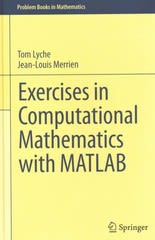Question
1. Are the following samples independent or dependent (paired)? As part of a marketing experiment, a department store regularly mailed discount coupons to 25 of
1. Are the following samples independent or dependent (paired)?
As part of a marketing experiment, a department store regularly mailed discount coupons to 25 of its credit card holders. Their total credit card purchases over the next three months were compared to the credit card purchases over the next three months for 25 credit card holders who were not sent discount coupons. Determine whether the samples are dependent or independent.
A) dependent
B) independent
2. When the variances of two populations are equal and we are performing a t-test for the difference between two means, we:
A) Do not change our calculations based on the equal variances
B) Use a pooled estimate for the standard deviation
C) Do not use a pooled estimate for the standard deviation
For the following hypothesis testing questions, you may use either the p-value method or the rejection region method. For full credit, be sure to show:
The null and alternative hypotheses
The p-value or test statistic/rejection region (depending on method used)
The decision (reject H0 or fail to reject H0)
The interpretation
3. In an effort to determine if rats perform certain tasks more quickly if offered larger rewards, the following experiment was performed. On day 1, a group of six rats was given a reward of one food pellet each time they ran a maze. On day 2, the same group of rats received five food pellets each time they ran a maze. The average time in seconds for each rat to run the maze is shown
| Rat | 1 | 2 | 3 | 4 | 5 | 6 |
| Time with one food pellet | 3.6 | 4.2 | 2.9 | 3.1 | 3.5 | 3.9 |
| Time with five food pellets | 3.0 | 3.7 | 3.0 | 3.3 | 2.8 | 3.0 |
Test the claim that rats will run the maze more quickly if offered a larger reward. Use a significance level of 0.05. (Hint: consider the units, if they run faster will the mean time be larger or smaller?)
4. A researcher is studying the SAT 1 Math scores of two groups of students: those who plan to apply for financial aid and those that do not. Two independent random samples yield the following:
| Do not plan to apply for financial aid | Plan to apply for financial aid |
| n 1 =35 | n2= 38 |
| s1= 123.1 | s2=119.4 |
| (Please note that bar is supposed to be over X but I could not figure out how to do it here) x1= 450 | (Please note that bar is supposed to be over X but I could not figure out how to do it here) x2=480 |
a) At a significance level of 0.05, is there evidence that students who do not plan to apply for financial aid had more variability on their SAT 1 math test scores than those who do plan to do so?
b) At a significance level of 0.05, is there evidence that the mean scores for each group are different? You may assume they do not have equal variances.
5. In a random sample of employees at large corporations, 75 of 125 management-level employees reported high satisfaction with their jobs. Of 210 entry-level employees, 122 reported the same. Does this provide evidence that the percentage of employees at large corporations that are highly satisfied with their job is higher for management-level employees than for entry-level employees? Use a significance level of 10%
Step by Step Solution
There are 3 Steps involved in it
Step: 1

Get Instant Access to Expert-Tailored Solutions
See step-by-step solutions with expert insights and AI powered tools for academic success
Step: 2

Step: 3

Ace Your Homework with AI
Get the answers you need in no time with our AI-driven, step-by-step assistance
Get Started


